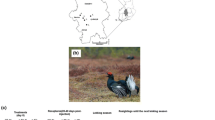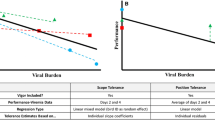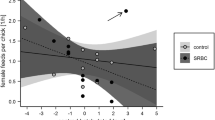Abstract
Immune responses constitute a major way for hosts to defend themselves against parasites. Because hosts do not habitually produce strong responses all the time, immune responses might be costly to produce or maintain. We tested experimentally if the production of a response to a challenge with a novel antigen resulted in a cost in terms of fitness using the highly colonial house martin Delichon urbica as a model system. We injected adult breeding birds during laying of the first clutch with either Newcastle disease virus (NDV) or a control injection, and the clutch was subsequently removed to induce relaying. NDV stimulates the non-specific immune system, causing production of antibodies during a period of more than 2 weeks. Accordingly, we found an increase in leukocyte counts in experimental birds compared to controls. Experimental treatment reduced the frequency of re-laying, caused a delay in timing of relaying and a reduction in brood size. Quality of nestlings in terms of body size, body mass and T-cell-mediated immune response did not differ significantly between treatments. Overall, seasonal reproductive success differed significantly between treatments, showing that the production of an immune response by adult birds is costly in terms of future fecundity.

Similar content being viewed by others
References
Alexander DJ (1997) Newcastle disease and other avian Paramyxoviridae infections. In: Calnek BW (ed) Diseases of poultry. Iowa State University Press, Ames, pp 541–582
Allander K, Sundberg J (1997) Temporal variation and reliability of blood parasite levels in captive yellowhammer males Emberiza citrinella. J Avian Biol 28:325–330
Arnold JM, Hatch JJ, Nisbet ICT (2004) Seasonal declines in reproductive success of the common tern Sterna hirundo: timing or parental quality? J Avian Biol 35:33–45
Baer B, Schmid-Hempel P (1999) Experimental variation in polyandry affects parasite loads and fitness in a bumblebee. Nature 397:151–154
Barbosa A, Merino S, Møller AP, de Lope F (2003) Effects of feather lice on the flight behavior of male barn swallows (Hirundo rustica). Auk 119:213–216
Brinkhof MWG, Cavé AJ, Perdeck AC (1993) Timing of reproduction and fledging success in the coot Fulica atra: evidence for a causal relationship. J Anim Ecol 62:577–587
Christe P, Møller AP, de Lope F (1998) Immunocompetence and nestling survival in the house martin: “the tasty chick hypothesis”. Oikos 83:175–179
Christe P, Møller AP, Saino N, de Lope F (2000) Genetic and environmental components of phenotypic variation in immune response and body size of a colonial bird, the house martin Delichon urbica. Heredity 85:75–83
Christe P, de Lope F, González G, Saino N, Møller AP (2001) The influence of environmental conditions on immune responses morphology and recapture probability of nestling house martins (Delichon urbica). Oecologia 126:333–338
Christe P, Møller AP, González G, de Lope F (2002) Intraseasonal variation in immune defence, body mass and hematocrit in adult house martin Delichon urbica. J Avian Biol 33:321–325
Crick HQP, Gibbons DW, Magrath RD (1993) Seasonal changes in clutch size in British birds. J Anim Ecol 62:263–273
de Lope F, González G, Pérez J, Møller AP (1993) Increased detrimental effects of ectoparasites on their bird hosts during adverse environmental conditions. Oecologia 95:234–240
Freitak D, Ots I, Vanatoa A, Hõrak P (2003) Immune response is energetically costly in white cabbage butterfly pupae. Proc R Soc Lond B 270 Suppl:S220–S222
Gessaman JA, Johnson JA, Hoffman SW (1986) Haematocrits and erythrocyte numbers for Cooper’s and sharp-shinned hawks. Condor 98:95–96
Giorgi MS, Arlettaz R, Christe P, Vogel P (2001) The energetic grooming costs imposed by a parasitic mite (Spinturnix myoti) upon its bat host (Myotis myotis). Proc R Soc Lond B 268:2071–2075
Hansson B, Bensch S, Hasselquist D (2000) The quality and the timing hypotheses evaluated using data on great reed warblers. Oikos 90:575–581
Hart BJ (1997) Behavioural defence. In: Clayton DH, Moore J (eds) Host-parasite evolution: general principles and avian models. Oxford University Press, Oxford, pp 59–77
Hatchwell BJ (1991) An experimental study of the effects of timing breeding on the reproductive success of common guillemots (Uria aalge). J Anim Ecol 60:721–736
Ilmonen P, Täärna T, Hasselquist D (2000) Experimentally activated immune defence in female pied flycatchers results in reduced breeding success. Proc R Soc Lond B 267:665–670
Jacot A, Scheuber H, Brinkhof MW (2004) Costs of an induced immune response on sexual display and longevity in field crickets. Evolution 58:2280–2286
Klasing KC (2004) The cost of immunity. Acta Zool Sinica 50:961–964
Kuiken T, Leighton FA, Wobeser G, Danesik KL, Riva J, Heckert RA (1998) An epidemic of Newcastle disease in double-crested cormorants from Saskatchewan. J Wildl Dis 34:457–471
Lochmiller RL, Deerenberg C (2000) Trade-offs in evolutionary immunology: just what is the cost of immunity? Oikos 88:87–98
Marzal A, de Lope F, Navarro C, Møller AP (2005) Malarial parasites decrease reproductive success: an experimental study in a passerine bird. Oecologia 142:541–545
Merino S, Potti J, Fargallo JA (1997) Blood parasites of some passerine birds from Central Spain. J Wildl Dis 33:638–641
Møller AP, Erritzøe J (1996) Parasite virulence and host immune defense: host immune response is related to nest reuse in birds. Evolution 50:2066–2072
Møller AP, Rózsa L (2005) Parasite biodiversity and host defenses: chewing lice and immune response of their avian hosts. Oecologia 142:169–176
Møller AP, Merino S, Brown CR, Robertson RJ (2001) Immune defense and host sociality: a comparative study of swallows and martins. Am Nat 158:136–145
Møller AP, Erritzøe J, Saino N (2003) Seasonal changes in immune response and parasite impact on hosts. Am Nat 161:657–671
Moore J (2002) Parasites and the behaviour of animals. Oxford University Press, Oxford
Mooring MS (1995) The effect of tick challenge on grooming rate by impala. Anim Behav 50:377–392
Moran MD (2003) Arguments for rejecting the sequential Bonferroni in ecological studies. Oikos 102:403–405
Moreno J (1998) The determination of seasonal declines in breeding success in seabirds. Etologia 6:17–31
Nakagawa S (2004) A farewell to Bonferroni: the problems of low statistical power and publication bias. Behav Ecol 15:1044–1045
Nordling D, Andersson M, Zohari S, Gustafsson L (1998) Reproductive effort reduces specific immune response and parasite resistance. Proc R Soc Lond B 265:1291–1298
Ots I, Kerimov AB, Ivankina EV, Ilyina TA, Hõrak P (2001) Immune challenge affects basal metabolic activity in wintering great tits. Proc R Soc Lond B 268:1475–1482
Parson J (1975) Seasonal variation in the breeding success of the herring gull: an experimental approach to pre-fledging success. J Anim Ecol 44:553–573
Perneger TV (1998) What’s wrong with Bonferroni adjustments. Br Med J 316:1236–1238
Råberg L, Grahn M, Hasselquist D, Svensson E (1998) On the adaptive significance of stress-induced immunosuppression. Proc R Soc Lond B 265:1637–1641
Råberg L, Nilsson JA, Ilmonen P, Stjernman M, Hasselquist D (2000) The cost of an immune response: vaccination reduces parental effort. Ecol Lett 3:382–386
Rahman MB, Rahman MM, Rahman M, Kabir SM, Nazir KH, Amin MM (2004) Efficacy of V4HR Newcastle disease (V4HR-ND) vaccine in broiler birds in Bangladesh. Int J Poultry Sci 3:365–368
Roitt I, Brostoff J, Male D (1996) Immunology. Mosby, London
Rosenthal R (1991) Meta-analytic procedures for social research. Sage, Thousand Oaks
Saino N, Ferrari R, Martinelli R, Romano M, Rubolini D, Møller AP (2002) Early maternal effects mediated by immunity depend on sexual ornamentation of the father in the barn swallow (Hirundo rustica). Proc R Soc Lond B 269:1005–1011
Sánchez-Guzmán JM, Villegas A, Corbacho C, Moran R, Marzal A, Real R (2004) Response of the haematocrit to body condition changes in northern bald ibis Geronticus eremita. Comp Biochem Physiol A Mol Integr Physiol 139:41–47
Smits J, Bortolotti G, Tella J (1999) Simplifying the phytohemagglutinin skin-testing technique in studies of avian immunocompetence. Funct Ecol 13:567–572
Svensson E, Råberg L, Koch C, Hasselquist D (1998) Energetic stress, immunosuppression and the costs of an antibody response. Funct Ecol 12:912–919
van Nouhuys S, Hanski I (2002) Colonization rates and distances of a host butterfly and two specific parasitoids in a fragmented landscape. J Anim Ecol 71:639–650
Verhulst S, Balen JHV, Tinbergen JM (1995) Seasonal decline in reproductive success of the great tit: variation in time or quality? Ecology 76:2392–2403
Verhulst S, Riedstra B, Wiersma P (2005) Brood size and immunity costs in zebra finches Taeniopygia guttata. J Avian Biol 36:22–30
Williams TD, Christians JK, Aiken JJ, Evanson M (1999) Enhanced immune function does not depress reproductive output. Proc R Soc Lond B 266:753–757
Acknowledgements
The research was funded by a research project of the Spanish Ministry of Education and Science (CGL2006-2937). AM was supported by a post-doctoral (EX-2006-0557) fellowship from the Spanish Ministry of Education and Science. MIR was supported by grants from the Spanish Ministry of Science (BES 2004-4886). We are grateful to two anonymous reviewers for suggestions to improve the article. The experiments comply with the current laws of Spain where the experiments were performed.
Author information
Authors and Affiliations
Corresponding author
Additional information
Communicated by I. Hartley
Rights and permissions
About this article
Cite this article
Marzal, A., Reviriego, M., de Lope, F. et al. Fitness costs of an immune response in the house martin (Delichon urbica). Behav Ecol Sociobiol 61, 1573–1580 (2007). https://doi.org/10.1007/s00265-007-0389-z
Received:
Revised:
Accepted:
Published:
Issue Date:
DOI: https://doi.org/10.1007/s00265-007-0389-z




